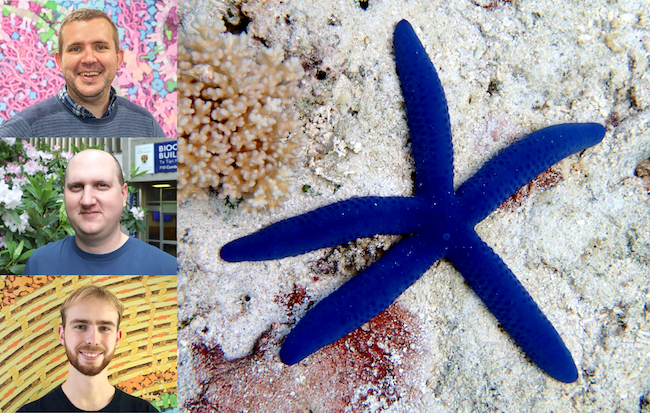
Dr Nathan Kenny and his collaborators have just been awarded a Catalyst Seeding grant to find out how blue pigment could protect royal blue sea stars from stressful environmental conditions.
Starfish, beloved creatures of the sea, are not actually fish. They are a type of echinoderm, closely related to sea urchins and sand dollars. Thus scientists prefer to call them sea stars, but maybe this is still a misnomer, because unlike stars that we look at in the sky, these creatures come in different colours.
Blue sea stars (Linckia laevigata) live in shallow waters across the tropical Indo-Pacific, and as the name states, often come in a beautiful royal blue colour, but can also appear in yellow, grey, purple, and other forms.
“Sea stars often possess beautiful and disparate colours, which are established by their genetic background and environment in ways that we are only just beginning to understand,” Nathan says.
The pigments of these sea stars consist of carotenoproteins - complexes of protein with carotenoid molecules, which are powerful antioxidants.
Scientists have found that antioxidant activity is greater in royal blue than in yellow-orange pigments. Also, the blue sea stars are more common in shallow water where they are more exposed to sunlight. Nathan's team thinks that the pigment helps the sea stars cope with oxidative damage, allowing them to tolerate extreme temperature and UV levels.
However, the genes and proteins that underlie sea star pigmentation, and how it links to their ecology and resilience, are not well understood.
Nathan has pulled together an international network of collaborators from New Zealand, the UK, Australia and Japan to examine sea star colour in detail, with expertise in genomics, protein biochemistry, biogeography, ecology and behaviour.
In the Otago Biochemistry Department, protein biochemist Dr Matthias Fellner will also be involved, and he and Nathan will co-supervise PhD student Caleb Trimble who will carry out some of the molecular analyses linking genotype to phenotype using comparative genomics and protein biochemistry.
This is only the beginning of a comprehensive research project, building on work begun at the Natural History Museum in London by Dr Suzanne Williams, one of the project's collaborators. Initially the team aims to demonstrate a link between individual pigments and the biochemical properties which allow animals to survive in extreme conditions.
After this, the team has many other aims: to find out the effect of individual colours on adaptation and ecology, how colour has evolved, and how other animals (of a variety of hues) will be affected by climate change in the near future.
“We anticipate that the knowledge we gain will inform policy and conservation decision making in a range of species,” Nathan says.
Above image. Left from top to bottom: Dr Nathan Kenny, Dr Matthias Fellner, Caleb Trimble. Right: Linckia laevigata - Blue sea star, Tonga islands (Dr Scott Mills | CC BY-SA 2.0)